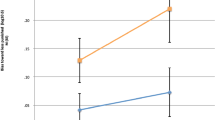Abstract
Twenty boys (6–8 years) rated by their teachers as hyperactive and a matched sample of nonhyperactive boys performed a task that required them to withhold responding for a set time interval in order to be rewarded (DRL 6-second schedule). Half of each group worked on a one-button console while the other half was provided with additional collateral buttons. Results indicated that hyperactive children were relatively unable to perform efficiently on the task, and that this deficit endured regardless of age, IQ, or experimental condition. DRL was thus found to discriminate accurately between teacher-rated and parent-rated hyperactive and nonhyperactive children. Furthermore, a wide variety of self-generated mediating behaviors was observed, and it was determined that a child's DRL performance was related to the kind of mediating behaviors he displayed. Results are discussed in terms of the clinical assessment of hyperactivity and the training of impulsive children.
Similar content being viewed by others
References
Bruner, A., & Revusky, S. A. Collateral behavior in humans.Journal of the Experimental Analysis of Behavior, 1961,4, 349–350.
Cantwell, D. P.The hyperactive child: Diagnosis, management, current research. New York: Spectrum Publications, 1975.
Conners, C. K. A teacher rating scale for use in drug studies with children.American Journal of Psychiatry, 1969,126, 152–156.
Davis, K., Sprague, R., & Werry, J. Stereotyped behavior and activity level in severe retardates: The effects of drugs.American Journal of Mental Deficiency, 1969,72, 721–727.
Doubros, S., & Daniels, G. An experimental approach to the reduction of overactive behavvior.Behaviour Research and Therapy, 1966,4, 251–258.
Douglas, V. I. Stop, look and listen: The problem of sustained attention and impulse control in hyperactive and normal children.Canadian Journal of Behavioral Science, 1972,4, 259–282.
Gittis, A., & Hothersall, D. DRL performance of juvenile rats with septal lesions.Physiological Psychology, 1974,2, 38–42.
Hothersall, D., Alexander, D., & Slonaker, R. The DRL deficit of rats with septal lesions: Effects of extended training in a mediated environmentPsychonomic Science, 1972,29(1), 34–36.
Hutt, D., Jackson, P., & Level, M. Behavior parameters and drug effects: A study of a hyperkinetic epileptic child.Epilepsia, 1966,7, 250–259.
Johnson, C. F. Limits on the measurement of activity levels in children using ultrasound and photoelectric cells.American Journal of Mental Deficiency, 1972,77, 301–310.
Lee, D., & Hutt, C. A play-room designed for filming children: A note.Journal of Child Psychology and Psychiatry, 1964,5, 263–265.
McConnel, T. B., Cromwell, R. F., & Bialev, I. A. Studies in activity level: VIII.American Journal of Mental Deficiency, 1964,68, 647–651.
Ounsted, C. The hyperactive syndrome in epileptic children.Lancet, 1955,269, 303–311.
Randolph, J. J. A further examination of collateral behavior in humans.Psychonomic Science, 1964,3, 227–228.
Schulman, J. L., & Reisman, J. M. An objective measure of hyperactivity.American Journal of Mental Deficiency, 1959,64, 455–456.
Slonaker, R. L. & Hothersall, D. Collateral behaviors and the DRL deficit of rats with septal lesions.Journal of Comparative and Physiological Psychology, 1972,80, 91–96.
Stein, N., & Flanagan, S. Human DRL performance, collateral behavior and verbalization of the reinforcement contingency.Bulletin of the Psychonomic Society, 1974,3, 27–28.
Stein, N., & Landis, R. Mediating role of human collateral behavior during a spaced responding schedule of reinforcement.Journal of Experimental Psychology, 1973,97, 28–33.
Stein, N., & Landis, R. Differential reinforcement of low rates performance by impulsive and reflective children.Journal of Experimental Child Psychology, 1975,19, 37–50.
Weisberg, P., & Tragakis, C. J. Analyses of DRL behavior in young children.Psychological Report, 1967,21, 709–715.
Werry, J. S., Sprague, R. L., & Cohen, M. N. Conners' Teacher Rating Scale for use in drug studies with children: An empirical study.Journal of Abnormal Child Psychology, 1975,3(3), 217–229.
Author information
Authors and Affiliations
Additional information
This report is based upon a dissertation submitted by the author in partial fulfillment for the Ph.D. degree. The efforts of Malcolm Helper, David Hothersall, Donald R. Meyer, Marilyn Moody, and Charles Wenar are gratefully acknowledged. The investigation was conducted while the author was a National Research Fellow, supported by Public Health Service Training Grant No. 5 T32 MH14608-02 to The Ohio State University.
Rights and permissions
About this article
Cite this article
Gordon, M. The assessment of impulsivity and mediating behaviors in hyperactive and nonhyperactive boys. J Abnorm Child Psychol 7, 317–326 (1979). https://doi.org/10.1007/BF00916541
Revised:
Issue Date:
DOI: https://doi.org/10.1007/BF00916541




